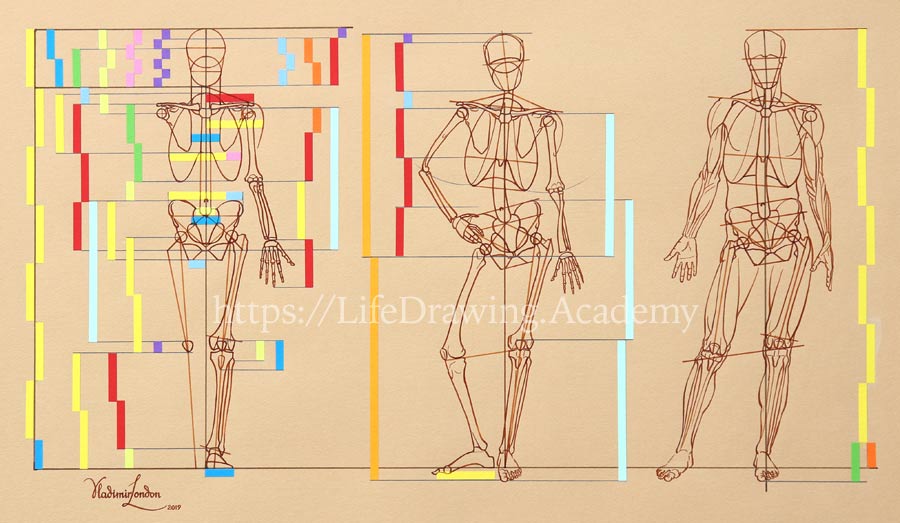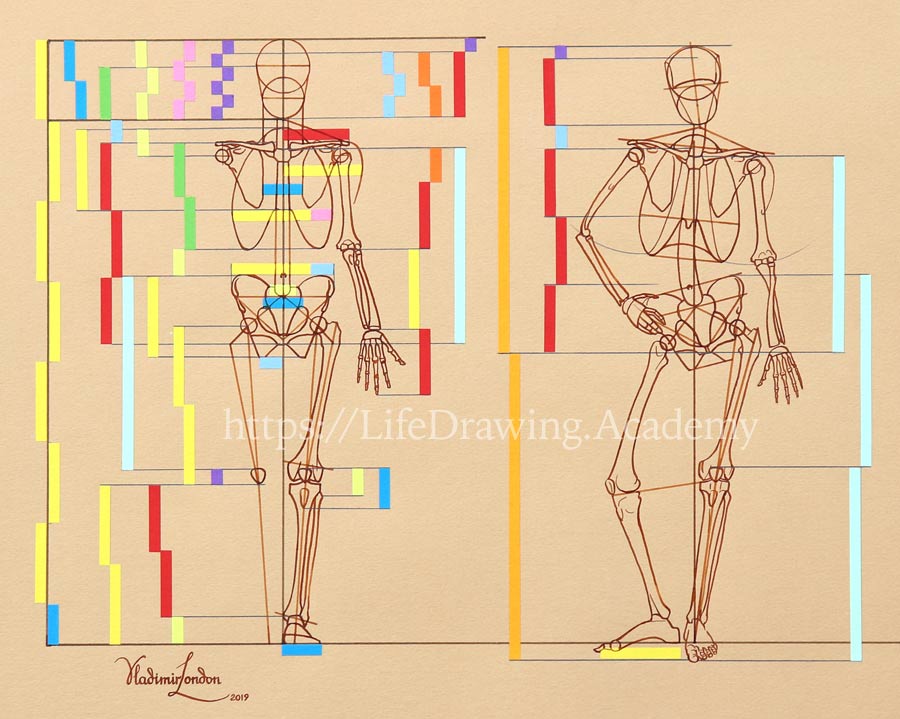Body Proportions
This is your unique chance to get a lifetime academy membership and a dedicated team of art teachers.
Such unlimited personal tutoring is not available anywhere else.
Enroll in the Life Drawing Academy now!
Human Body Proportions
Canon 3
By Vladimir London
In this video lesson, you will discover a canon of human body proportions that is taught in leading art academies of Russia. It originates from classical Greek and Roman sculpture, and it developed further during the Renaissance period. Many of these proportions were also described by German art professor Gottfried Bammes in his books. As this is more "engineering" than creative drawing, I will use a ruler and pen and ink to craft the diagrams.

The top horizontal line is the top of the figure, and the bottom line represents the ground. The vertical axis of a standing figure is divided into seven and a half sections. This is because this dimension is more common in life than the eight-heads figures. The major measuring unit will be the height of the head, which is marked here in yellow. The half of the head is color-coded in blue. The head is divided into six equal parts. The height of the face is five-sixths of the head. The head is also divided into three equal parts. The two-thirds of the head is the level of its widest part. The height of the head is equal to the distance from the seventh vertebra to the end of the breast bone. From the chin to the pit of the neck is one-third of the face.
The length of the breastbone equals the height of the face. The distance from the pit of the neck to the bottom edge of the ribcage is twice the size of two-thirds of the head. The height of the head can also be divided into three equal parts. One-third of the head is the distance from the seventh vertebra to the shoulder joint. The height of the face is the same as the length of the collarbone together with the acromion. The height of the head is equal to the width of one shoulder. Half of the head is equal to the distance between the shoulder blades. The width of the ribcage is the same as the height of the head plus one-fourth of the head's height.
I will now continue with the pelvis. The width of the pelvis is equal to the height of the head plus one-third of the face. The pelvis is a bit wider than the ribcage. The distance from the pit of the neck to the end of the breastbone is equal to the distance from the breastbone to the top of the pelvis, and it is the same as from the top of the pelvis to the pubic bone. Each of these dimensions is equal to the height of the face. The distance from the end of the ribcage to the top of the pelvis is equal to one-third of the head. The height of the head is the same as the height of the pelvis. Horizontal measurements of the sacrum are similar to one-third and one-half of the head's height. The distance from the central line to the sit-bone is equal to the one-third of the face. The distance from the hip joint to the knee joint is twice the height of the head. The distance from the knee joint to the ground is also two times greater than the head's height. The height of the kneecap is one-sixth of the head's height.

Here's another important proportion to know. The distance from the top of the pelvis to the top of the kneecap is the same as the distance from the pit of the neck to the pubic bone. We can now examine the proportions of a leg. The width of one foot is the same as the one-half of the head's height. The distance from the top of the kneecap to the bottom of the tibial tuberosity is half the height of the head. The distance from the top of the kneecap to the calf bone is one-third of the head's height. The length of the shinbone is twice the height of the face. The height of the foot is one-third of the head.
Now, let's examine the proportions of an arm. The length of the upper arm bone is one and a half times the height of the face. The length of the forearm bones is similar to the head's height. The length of the hand is the same is the height of the face. In fine art, figures very seldom stand at attention. The most common standing pose is the contrapposto. In such a pose, the body weight is supported by one leg, while the other leg is relaxed.
Let's check how this affects construction and proportions. The axis of the supporting leg is tilted from its normal position. In turn, the pelvis is shifted, and also, it is tilted diagonally. This diagonal inclination happens because the center of the body's weight is over the supporting leg footprint. Also, because our point of view is higher than the ground, we see the toes from above, and they appear slightly lower than the bottom horizontal line.
In contrapposto, the center of gravity projects not to the point between the feet but to the footprint of the supporting leg. This animation shows what happens to the construction of the lower body in contrapposto. The center of gravity is shifted and now points to the footprint. The distance from the toes to the pubic bone is the same as the distance from the pubic bone to the top of the figure. You can notice that the top of the figure is a bit lower in contrapposto than in the attention pose. We can now apply the measurements of the head—one-sixth of the head and the height of the face. We can also add one-third of the face to locate the pit of the neck. In some figures this dimension can be equal to one-third of the head instead of the face.
In this pose, the pit of the neck lies on the same vertical line as the footprint of the supporting leg and the center of gravity. Due to the shift of the body in contrapposto, the head is slightly tilted to one side. The distance from the pit of the neck to the pubic bone can be divided into three equal parts. Each part is equal to the height of the face. The first part is the height of the breastbone. The second part is from the breastbone to the top of the pelvis. And the third part is from the top of the pelvis or navel to the pubic bone. To compensate the tilt of the pelvis, the spinal column is laterally curved.
Here's an important proportion in contrapposto: The distance from the pit of the neck to the pubic bone is equal to the distance from the top of the pelvis to the top of the kneecap. It is also equal to the distance from the top of the kneecap to the toes. I will now depict the relaxed leg. The line of the two knees follows the tilt of the pelvis. The length of the foot is slightly bigger than the head's height.
Here's a good tip when drawing an arm resting on the hip: first draw the hand, and then add the forearm to avoid misplacement of the hand. The elbow is on the same level as the end of the ribcage. We can do a semicircle to keep this level for a raised arm. The same rule works for the other arm. The forearm on the right is in the pronation position. This means that the two forearm bones are crossed.
In the previous drawing, these bones were in the supination position and therefore parallel to each other. Here is another drawing of a figure in the contrapposto. This time I added muscles' outlines. Because the figure in contrapposto is slightly lower, the head fits to the ground seven times plus the half of the face. The figure's height to the toes is seven heads plus two-thirds of the head...
[ The full lesson is avaibale to Life Drawing Academy members ]
This is your unique chance to get a lifetime academy membership and a dedicated team of art teachers.
Such unlimited personal tutoring is not available anywhere else.




